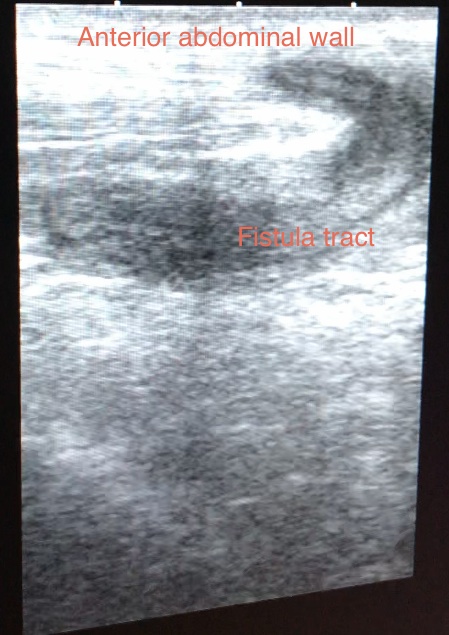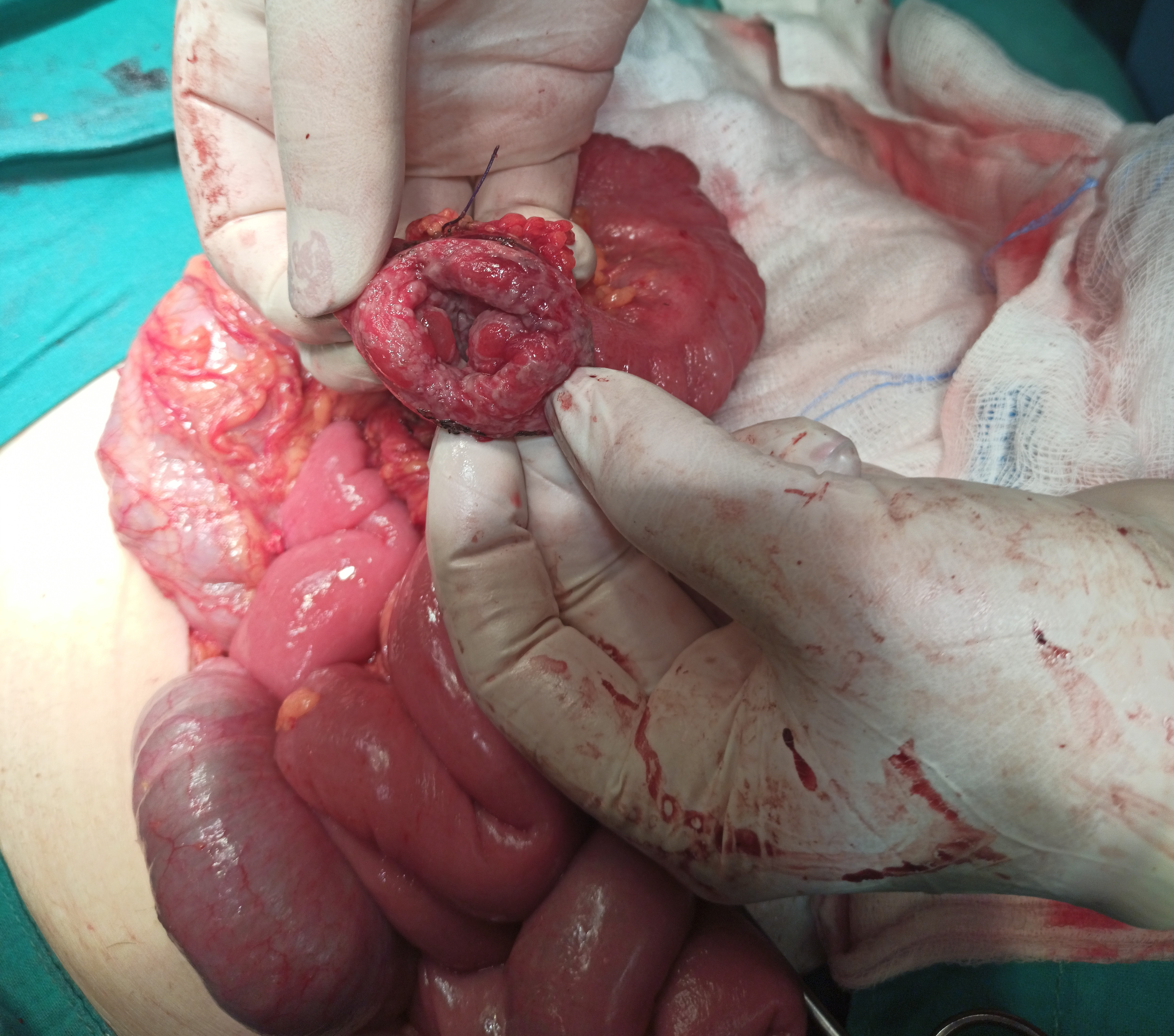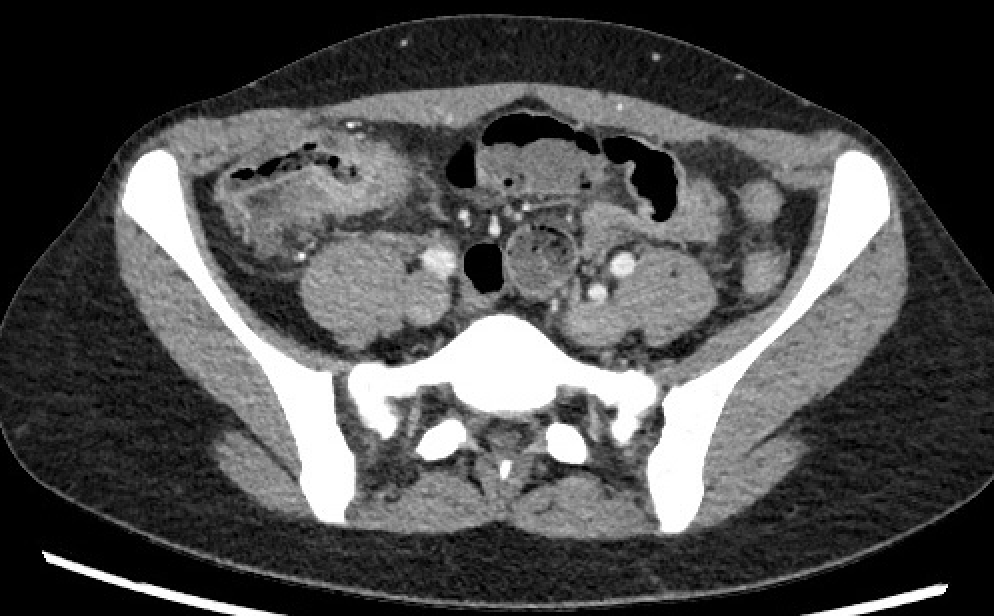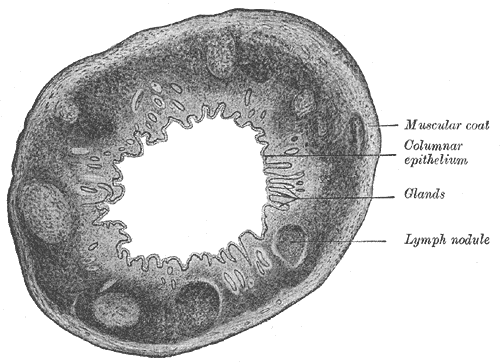[1]
Peyrin-Biroulet L, Loftus EV Jr, Colombel JF, Sandborn WJ. The natural history of adult Crohn's disease in population-based cohorts. The American journal of gastroenterology. 2010 Feb:105(2):289-97. doi: 10.1038/ajg.2009.579. Epub 2009 Oct 27
[PubMed PMID: 19861953]
[2]
Thia KT, Sandborn WJ, Harmsen WS, Zinsmeister AR, Loftus EV Jr. Risk factors associated with progression to intestinal complications of Crohn's disease in a population-based cohort. Gastroenterology. 2010 Oct:139(4):1147-55. doi: 10.1053/j.gastro.2010.06.070. Epub 2010 Jul 14
[PubMed PMID: 20637205]
[3]
Lightner AL, McKenna NP, Alsughayer A, Loftus EV Jr, Raffals LE, Faubion WA, Moir C. Anti-TNF biologic therapy does not increase postoperative morbidity in pediatric Crohn's patients. Journal of pediatric surgery. 2019 Oct:54(10):2162-2165. doi: 10.1016/j.jpedsurg.2019.01.006. Epub 2019 Jan 18
[PubMed PMID: 30773391]
[4]
Marazuela García P, López-Frías López-Jurado A, Vicente Bártulos A. Acute abdominal pain in patients with Crohn's disease: what urgent imaging tests should be done? Radiologia. 2019 Jul-Aug:61(4):333-336. doi: 10.1016/j.rx.2018.12.003. Epub 2019 Feb 14
[PubMed PMID: 30772003]
[5]
Aksan A, Farrag K, Stein J. An update on the evaluation and management of iron deficiency anemia in inflammatory bowel disease. Expert review of gastroenterology & hepatology. 2019 Feb:13(2):95-97. doi: 10.1080/17474124.2019.1553618. Epub 2018 Dec 7
[PubMed PMID: 30791779]
[6]
Hwang JH, Yu CS. Depression and resilience in ulcerative colitis and Crohn's disease patients with ostomy. International wound journal. 2019 Mar:16 Suppl 1(Suppl 1):62-70. doi: 10.1111/iwj.13076. Epub
[PubMed PMID: 30793856]
[7]
Khan S, Rupniewska E, Neighbors M, Singer D, Chiarappa J, Obando C. Real-world evidence on adherence, persistence, switching and dose escalation with biologics in adult inflammatory bowel disease in the United States: A systematic review. Journal of clinical pharmacy and therapeutics. 2019 Aug:44(4):495-507. doi: 10.1111/jcpt.12830. Epub 2019 Mar 14
[PubMed PMID: 30873648]
Level 1 (high-level) evidence
[8]
Liu JZ, van Sommeren S, Huang H, Ng SC, Alberts R, Takahashi A, Ripke S, Lee JC, Jostins L, Shah T, Abedian S, Cheon JH, Cho J, Dayani NE, Franke L, Fuyuno Y, Hart A, Juyal RC, Juyal G, Kim WH, Morris AP, Poustchi H, Newman WG, Midha V, Orchard TR, Vahedi H, Sood A, Sung JY, Malekzadeh R, Westra HJ, Yamazaki K, Yang SK, International Multiple Sclerosis Genetics Consortium, International IBD Genetics Consortium, Barrett JC, Alizadeh BZ, Parkes M, Bk T, Daly MJ, Kubo M, Anderson CA, Weersma RK. Association analyses identify 38 susceptibility loci for inflammatory bowel disease and highlight shared genetic risk across populations. Nature genetics. 2015 Sep:47(9):979-986. doi: 10.1038/ng.3359. Epub 2015 Jul 20
[PubMed PMID: 26192919]
[9]
Franke A, McGovern DP, Barrett JC, Wang K, Radford-Smith GL, Ahmad T, Lees CW, Balschun T, Lee J, Roberts R, Anderson CA, Bis JC, Bumpstead S, Ellinghaus D, Festen EM, Georges M, Green T, Haritunians T, Jostins L, Latiano A, Mathew CG, Montgomery GW, Prescott NJ, Raychaudhuri S, Rotter JI, Schumm P, Sharma Y, Simms LA, Taylor KD, Whiteman D, Wijmenga C, Baldassano RN, Barclay M, Bayless TM, Brand S, Büning C, Cohen A, Colombel JF, Cottone M, Stronati L, Denson T, De Vos M, D'Inca R, Dubinsky M, Edwards C, Florin T, Franchimont D, Gearry R, Glas J, Van Gossum A, Guthery SL, Halfvarson J, Verspaget HW, Hugot JP, Karban A, Laukens D, Lawrance I, Lemann M, Levine A, Libioulle C, Louis E, Mowat C, Newman W, Panés J, Phillips A, Proctor DD, Regueiro M, Russell R, Rutgeerts P, Sanderson J, Sans M, Seibold F, Steinhart AH, Stokkers PC, Torkvist L, Kullak-Ublick G, Wilson D, Walters T, Targan SR, Brant SR, Rioux JD, D'Amato M, Weersma RK, Kugathasan S, Griffiths AM, Mansfield JC, Vermeire S, Duerr RH, Silverberg MS, Satsangi J, Schreiber S, Cho JH, Annese V, Hakonarson H, Daly MJ, Parkes M. Genome-wide meta-analysis increases to 71 the number of confirmed Crohn's disease susceptibility loci. Nature genetics. 2010 Dec:42(12):1118-25. doi: 10.1038/ng.717. Epub
[PubMed PMID: 21102463]
Level 1 (high-level) evidence
[10]
Lee HS, Oh H, Yang SK, Baek J, Jung S, Hong M, Kim KM, Shin HD, Kim KJ, Park SH, Ye BD, Han B, Song K. X Chromosome-wide Association Study Identifies a Susceptibility Locus for Inflammatory Bowel Disease in Koreans. Journal of Crohn's & colitis. 2017 Jul 1:11(7):820-830. doi: 10.1093/ecco-jcc/jjx023. Epub
[PubMed PMID: 28333213]
[11]
Zaidi D, Wine E. Regulation of Nuclear Factor Kappa-Light-Chain-Enhancer of Activated B Cells (NF-κβ) in Inflammatory Bowel Diseases. Frontiers in pediatrics. 2018:6():317. doi: 10.3389/fped.2018.00317. Epub 2018 Oct 30
[PubMed PMID: 30425977]
[12]
Ghersin I, Khteeb N, Katz LH, Daher S, Shamir R, Assa A. Trends in the epidemiology of inflammatory bowel disease among Jewish Israeli adolescents: a population-based study. Alimentary pharmacology & therapeutics. 2019 Mar:49(5):556-563. doi: 10.1111/apt.15160. Epub 2019 Jan 27
[PubMed PMID: 30687945]
[13]
Coward S, Clement F, Benchimol EI, Bernstein CN, Avina-Zubieta JA, Bitton A, Carroll MW, Hazlewood G, Jacobson K, Jelinski S, Deardon R, Jones JL, Kuenzig ME, Leddin D, McBrien KA, Murthy SK, Nguyen GC, Otley AR, Panaccione R, Rezaie A, Rosenfeld G, Peña-Sánchez JN, Singh H, Targownik LE, Kaplan GG. Past and Future Burden of Inflammatory Bowel Diseases Based on Modeling of Population-Based Data. Gastroenterology. 2019 Apr:156(5):1345-1353.e4. doi: 10.1053/j.gastro.2019.01.002. Epub 2019 Jan 10
[PubMed PMID: 30639677]
[14]
Gálvez J. Role of Th17 Cells in the Pathogenesis of Human IBD. ISRN inflammation. 2014:2014():928461. doi: 10.1155/2014/928461. Epub 2014 Mar 25
[PubMed PMID: 25101191]
[15]
Targan SR. Biology of inflammation in Crohn's disease: mechanisms of action of anti-TNF-a therapy. Canadian journal of gastroenterology = Journal canadien de gastroenterologie. 2000 Sep:14 Suppl C():13C-16C
[PubMed PMID: 11023555]
[16]
Kanai T, Watanabe M, Okazawa A, Nakamaru K, Okamoto M, Naganuma M, Ishii H, Ikeda M, Kurimoto M, Hibi T. Interleukin 18 is a potent proliferative factor for intestinal mucosal lymphocytes in Crohn's disease. Gastroenterology. 2000 Dec:119(6):1514-23
[PubMed PMID: 11113073]
[17]
Greuter T, Piller A, Fournier N, Safroneeva E, Straumann A, Biedermann L, Godat S, Nydegger A, Scharl M, Rogler G, Vavricka SR, Schoepfer AM, Swiss IBD Cohort Study Group. Upper Gastrointestinal Tract Involvement in Crohn's Disease: Frequency, Risk Factors, and Disease Course. Journal of Crohn's & colitis. 2018 Nov 28:12(12):1399-1409. doi: 10.1093/ecco-jcc/jjy121. Epub
[PubMed PMID: 30165603]
[18]
Fumery M, Pariente B, Sarter H, Savoye G, Spyckerelle C, Djeddi D, Mouterde O, Bouguen G, Ley D, Peneau A, Dupas JL, Turck D, Gower-Rousseau C, Epimad Group. Long-term outcome of pediatric-onset Crohn's disease: A population-based cohort study. Digestive and liver disease : official journal of the Italian Society of Gastroenterology and the Italian Association for the Study of the Liver. 2019 Apr:51(4):496-502. doi: 10.1016/j.dld.2018.11.033. Epub 2018 Dec 23
[PubMed PMID: 30611597]
[19]
Owczarek D, Cibor D, Głowacki MK, Rodacki T, Mach T. Inflammatory bowel disease: epidemiology, pathology and risk factors for hypercoagulability. World journal of gastroenterology. 2014 Jan 7:20(1):53-63. doi: 10.3748/wjg.v20.i1.53. Epub
[PubMed PMID: 24415858]
[20]
Fadeeva NA, Korneeva IA, Knyazev OV, Parfenov AI. Biomarkers of inflammatory bowel disease activity. Terapevticheskii arkhiv. 2018 Dec 30:90(12):107-111. doi: 10.26442/00403660.2018.12.000018. Epub
[PubMed PMID: 30701842]
[21]
Parfenov AI, Knyazev OV, Kagramanova AV, Fadeeva NA. Personalized medicine in the treatment of inflammatory bowel diseases. Terapevticheskii arkhiv. 2018 Feb 15:90(2):4-11. doi: 10.26442/terarkh20189024-11. Epub
[PubMed PMID: 30701765]
[22]
Kedia S, Das P, Madhusudhan KS, Dattagupta S, Sharma R, Sahni P, Makharia G, Ahuja V. Differentiating Crohn's disease from intestinal tuberculosis. World journal of gastroenterology. 2019 Jan 28:25(4):418-432. doi: 10.3748/wjg.v25.i4.418. Epub
[PubMed PMID: 30700939]
[23]
Moon JS. Clinical Aspects and Treatments for Pediatric Inflammatory Bowel Diseases. Pediatric gastroenterology, hepatology & nutrition. 2019 Jan:22(1):50-56. doi: 10.5223/pghn.2019.22.1.50. Epub 2019 Jan 10
[PubMed PMID: 30671373]
[24]
Lichtenstein GR, Loftus EV, Isaacs KL, Regueiro MD, Gerson LB, Sands BE. ACG Clinical Guideline: Management of Crohn's Disease in Adults. The American journal of gastroenterology. 2018 Apr:113(4):481-517. doi: 10.1038/ajg.2018.27. Epub 2018 Mar 27
[PubMed PMID: 29610508]
[25]
Torres J, Bonovas S, Doherty G, Kucharzik T, Gisbert JP, Raine T, Adamina M, Armuzzi A, Bachmann O, Bager P, Biancone L, Bokemeyer B, Bossuyt P, Burisch J, Collins P, El-Hussuna A, Ellul P, Frei-Lanter C, Furfaro F, Gingert C, Gionchetti P, Gomollon F, González-Lorenzo M, Gordon H, Hlavaty T, Juillerat P, Katsanos K, Kopylov U, Krustins E, Lytras T, Maaser C, Magro F, Marshall JK, Myrelid P, Pellino G, Rosa I, Sabino J, Savarino E, Spinelli A, Stassen L, Uzzan M, Vavricka S, Verstockt B, Warusavitarne J, Zmora O, Fiorino G. ECCO Guidelines on Therapeutics in Crohn's Disease: Medical Treatment. Journal of Crohn's & colitis. 2020 Jan 1:14(1):4-22. doi: 10.1093/ecco-jcc/jjz180. Epub
[PubMed PMID: 31711158]
[26]
Rahier JF, Magro F, Abreu C, Armuzzi A, Ben-Horin S, Chowers Y, Cottone M, de Ridder L, Doherty G, Ehehalt R, Esteve M, Katsanos K, Lees CW, Macmahon E, Moreels T, Reinisch W, Tilg H, Tremblay L, Veereman-Wauters G, Viget N, Yazdanpanah Y, Eliakim R, Colombel JF, European Crohn's and Colitis Organisation (ECCO). Second European evidence-based consensus on the prevention, diagnosis and management of opportunistic infections in inflammatory bowel disease. Journal of Crohn's & colitis. 2014 Jun:8(6):443-68. doi: 10.1016/j.crohns.2013.12.013. Epub 2014 Mar 6
[PubMed PMID: 24613021]
Level 3 (low-level) evidence
[27]
Ford AC, Kane SV, Khan KJ, Achkar JP, Talley NJ, Marshall JK, Moayyedi P. Efficacy of 5-aminosalicylates in Crohn's disease: systematic review and meta-analysis. The American journal of gastroenterology. 2011 Apr:106(4):617-29. doi: 10.1038/ajg.2011.71. Epub 2011 Mar 15
[PubMed PMID: 21407190]
Level 1 (high-level) evidence
[28]
Chande N, Patton PH, Tsoulis DJ, Thomas BS, MacDonald JK. Azathioprine or 6-mercaptopurine for maintenance of remission in Crohn's disease. The Cochrane database of systematic reviews. 2015 Oct 30:2015(10):CD000067. doi: 10.1002/14651858.CD000067.pub3. Epub 2015 Oct 30
[PubMed PMID: 26517527]
Level 1 (high-level) evidence
[29]
Chande N, Tsoulis DJ, MacDonald JK. Azathioprine or 6-mercaptopurine for induction of remission in Crohn's disease. The Cochrane database of systematic reviews. 2013 Apr 30:(4):CD000545. doi: 10.1002/14651858.CD000545.pub4. Epub 2013 Apr 30
[PubMed PMID: 23633304]
Level 1 (high-level) evidence
[30]
McDonald JW, Wang Y, Tsoulis DJ, MacDonald JK, Feagan BG. Methotrexate for induction of remission in refractory Crohn's disease. The Cochrane database of systematic reviews. 2014 Aug 6:2014(8):CD003459. doi: 10.1002/14651858.CD003459.pub4. Epub 2014 Aug 6
[PubMed PMID: 25099640]
Level 1 (high-level) evidence
[31]
Feagan BG, Fedorak RN, Irvine EJ, Wild G, Sutherland L, Steinhart AH, Greenberg GR, Koval J, Wong CJ, Hopkins M, Hanauer SB, McDonald JW. A comparison of methotrexate with placebo for the maintenance of remission in Crohn's disease. North American Crohn's Study Group Investigators. The New England journal of medicine. 2000 Jun 1:342(22):1627-32
[PubMed PMID: 10833208]
[32]
Richard VS, Al-Ismail D, Salamat A. Should we test TPMT enzyme levels before starting azathioprine? Hematology (Amsterdam, Netherlands). 2007 Aug:12(4):359-60
[PubMed PMID: 17654066]
[33]
Colombel JF, Sandborn WJ, Reinisch W, Mantzaris GJ, Kornbluth A, Rachmilewitz D, Lichtiger S, D'Haens G, Diamond RH, Broussard DL, Tang KL, van der Woude CJ, Rutgeerts P, SONIC Study Group. Infliximab, azathioprine, or combination therapy for Crohn's disease. The New England journal of medicine. 2010 Apr 15:362(15):1383-95. doi: 10.1056/NEJMoa0904492. Epub
[PubMed PMID: 20393175]
[34]
Kawalec P, Mikrut A, Wiśniewska N, Pilc A. Tumor necrosis factor-α antibodies (infliximab, adalimumab and certolizumab) in Crohn's disease: systematic review and meta-analysis. Archives of medical science : AMS. 2013 Oct 31:9(5):765-79. doi: 10.5114/aoms.2013.38670. Epub 2013 Nov 5
[PubMed PMID: 24273556]
Level 1 (high-level) evidence
[35]
Van Assche G, Lewis JD, Lichtenstein GR, Loftus EV, Ouyang Q, Panes J, Siegel CA, Sandborn WJ, Travis SP, Colombel JF. The London position statement of the World Congress of Gastroenterology on Biological Therapy for IBD with the European Crohn's and Colitis Organisation: safety. The American journal of gastroenterology. 2011 Sep:106(9):1594-602; quiz 1593, 1603. doi: 10.1038/ajg.2011.211. Epub 2011 Aug 16
[PubMed PMID: 21844919]
[36]
De Felice KM, Kane S. Safety of anti-TNF agents in pregnancy. The Journal of allergy and clinical immunology. 2021 Sep:148(3):661-667. doi: 10.1016/j.jaci.2021.07.005. Epub
[PubMed PMID: 34489011]
[37]
Hui S, Sinopoulou V, Gordon M, Aali G, Krishna A, Ding NS, Boyapati RK. Vedolizumab for induction and maintenance of remission in Crohn's disease. The Cochrane database of systematic reviews. 2023 Jul 17:7(7):CD013611. doi: 10.1002/14651858.CD013611.pub2. Epub 2023 Jul 17
[PubMed PMID: 37458279]
Level 1 (high-level) evidence
[38]
Hazlewood GS, Rezaie A, Borman M, Panaccione R, Ghosh S, Seow CH, Kuenzig E, Tomlinson G, Siegel CA, Melmed GY, Kaplan GG. Comparative effectiveness of immunosuppressants and biologics for inducing and maintaining remission in Crohn's disease: a network meta-analysis. Gastroenterology. 2015 Feb:148(2):344-54.e5; quiz e14-5. doi: 10.1053/j.gastro.2014.10.011. Epub 2014 Oct 16
[PubMed PMID: 25448924]
Level 1 (high-level) evidence
[39]
Feagan BG, Sandborn WJ, Gasink C, Jacobstein D, Lang Y, Friedman JR, Blank MA, Johanns J, Gao LL, Miao Y, Adedokun OJ, Sands BE, Hanauer SB, Vermeire S, Targan S, Ghosh S, de Villiers WJ, Colombel JF, Tulassay Z, Seidler U, Salzberg BA, Desreumaux P, Lee SD, Loftus EV Jr, Dieleman LA, Katz S, Rutgeerts P, UNITI–IM-UNITI Study Group. Ustekinumab as Induction and Maintenance Therapy for Crohn's Disease. The New England journal of medicine. 2016 Nov 17:375(20):1946-1960
[PubMed PMID: 27959607]
[40]
D'Haens G, Panaccione R, Baert F, Bossuyt P, Colombel JF, Danese S, Dubinsky M, Feagan BG, Hisamatsu T, Lim A, Lindsay JO, Loftus EV Jr, Panés J, Peyrin-Biroulet L, Ran Z, Rubin DT, Sandborn WJ, Schreiber S, Neimark E, Song A, Kligys K, Pang Y, Pivorunas V, Berg S, Duan WR, Huang B, Kalabic J, Liao X, Robinson A, Wallace K, Ferrante M. Risankizumab as induction therapy for Crohn's disease: results from the phase 3 ADVANCE and MOTIVATE induction trials. Lancet (London, England). 2022 May 28:399(10340):2015-2030. doi: 10.1016/S0140-6736(22)00467-6. Epub
[PubMed PMID: 35644154]
[41]
Ferrante M, Panaccione R, Baert F, Bossuyt P, Colombel JF, Danese S, Dubinsky M, Feagan BG, Hisamatsu T, Lim A, Lindsay JO, Loftus EV Jr, Panés J, Peyrin-Biroulet L, Ran Z, Rubin DT, Sandborn WJ, Schreiber S, Neimark E, Song A, Kligys K, Pang Y, Pivorunas V, Berg S, Duan WR, Huang B, Kalabic J, Liao X, Robinson A, Wallace K, D'Haens G. Risankizumab as maintenance therapy for moderately to severely active Crohn's disease: results from the multicentre, randomised, double-blind, placebo-controlled, withdrawal phase 3 FORTIFY maintenance trial. Lancet (London, England). 2022 May 28:399(10340):2031-2046. doi: 10.1016/S0140-6736(22)00466-4. Epub
[PubMed PMID: 35644155]
Level 1 (high-level) evidence
[42]
Papp K, Gottlieb AB, Naldi L, Pariser D, Ho V, Goyal K, Fakharzadeh S, Chevrier M, Calabro S, Langholff W, Krueger G. Safety Surveillance for Ustekinumab and Other Psoriasis Treatments From the Psoriasis Longitudinal Assessment and Registry (PSOLAR). Journal of drugs in dermatology : JDD. 2015 Jul:14(7):706-14
[PubMed PMID: 26151787]
[43]
Loftus EV Jr, Panés J, Lacerda AP, Peyrin-Biroulet L, D'Haens G, Panaccione R, Reinisch W, Louis E, Chen M, Nakase H, Begun J, Boland BS, Phillips C, Mohamed MF, Liu J, Geng Z, Feng T, Dubcenco E, Colombel JF. Upadacitinib Induction and Maintenance Therapy for Crohn's Disease. The New England journal of medicine. 2023 May 25:388(21):1966-1980. doi: 10.1056/NEJMoa2212728. Epub
[PubMed PMID: 37224198]
[44]
Akiyama S, Steinberg JM, Kobayashi M, Suzuki H, Tsuchiya K. Pregnancy and medications for inflammatory bowel disease: An updated narrative review. World journal of clinical cases. 2023 Mar 16:11(8):1730-1740. doi: 10.12998/wjcc.v11.i8.1730. Epub
[PubMed PMID: 36969991]
Level 3 (low-level) evidence
[45]
Singh S, Proctor D, Scott FI, Falck-Ytter Y, Feuerstein JD. AGA Technical Review on the Medical Management of Moderate to Severe Luminal and Perianal Fistulizing Crohn's Disease. Gastroenterology. 2021 Jun:160(7):2512-2556.e9. doi: 10.1053/j.gastro.2021.04.023. Epub
[PubMed PMID: 34051985]
[46]
Wang X, Shen B. Advances in Perianal Disease Associated with Crohn's Disease-Evolving Approaches. Gastrointestinal endoscopy clinics of North America. 2019 Jul:29(3):515-530. doi: 10.1016/j.giec.2019.02.011. Epub
[PubMed PMID: 31078250]
Level 3 (low-level) evidence
[47]
Lightner AL, Vogel JD, Carmichael JC, Keller DS, Shah SA, Mahadevan U, Kane SV, Paquette IM, Steele SR, Feingold DL. The American Society of Colon and Rectal Surgeons Clinical Practice Guidelines for the Surgical Management of Crohn's Disease. Diseases of the colon and rectum. 2020 Aug:63(8):1028-1052. doi: 10.1097/DCR.0000000000001716. Epub
[PubMed PMID: 32692069]
Level 1 (high-level) evidence
[48]
Maser EA, Sachar DB, Kruse D, Harpaz N, Ullman T, Bauer JJ. High rates of metachronous colon cancer or dysplasia after segmental resection or subtotal colectomy in Crohn's colitis. Inflammatory bowel diseases. 2013 Aug:19(9):1827-32. doi: 10.1097/MIB.0b013e318289c166. Epub
[PubMed PMID: 23669402]
[49]
Derikx LAAP, Nissen LHC, Smits LJT, Shen B, Hoentjen F. Risk of Neoplasia After Colectomy in Patients With Inflammatory Bowel Disease: A Systematic Review and Meta-analysis. Clinical gastroenterology and hepatology : the official clinical practice journal of the American Gastroenterological Association. 2016 Jun:14(6):798-806.e20. doi: 10.1016/j.cgh.2015.08.042. Epub 2015 Sep 25
[PubMed PMID: 26407752]
Level 1 (high-level) evidence
[50]
Ananthakrishnan AN, Adler J, Chachu KA, Nguyen NH, Siddique SM, Weiss JM, Sultan S, Velayos FS, Cohen BL, Singh S, AGA Clinical Guidelines Committee. Electronic address: clinicalpractice@gastro.org. AGA Clinical Practice Guideline on the Role of Biomarkers for the Management of Crohn's Disease. Gastroenterology. 2023 Dec:165(6):1367-1399. doi: 10.1053/j.gastro.2023.09.029. Epub
[PubMed PMID: 37981354]
Level 1 (high-level) evidence
[51]
Brown SR, Fearnhead NS, Faiz OD, Abercrombie JF, Acheson AG, Arnott RG, Clark SK, Clifford S, Davies RJ, Davies MM, Douie WJP, Dunlop MG, Epstein JC, Evans MD, George BD, Guy RJ, Hargest R, Hawthorne AB, Hill J, Hughes GW, Limdi JK, Maxwell-Armstrong CA, O'Connell PR, Pinkney TD, Pipe J, Sagar PM, Singh B, Soop M, Terry H, Torkington J, Verjee A, Walsh CJ, Warusavitarne JH, Williams AB, Williams GL, Wilson RG, ACPGBI IBD Surgery Consensus Collaboration. The Association of Coloproctology of Great Britain and Ireland consensus guidelines in surgery for inflammatory bowel disease. Colorectal disease : the official journal of the Association of Coloproctology of Great Britain and Ireland. 2018 Dec:20 Suppl 8():3-117. doi: 10.1111/codi.14448. Epub
[PubMed PMID: 30508274]
Level 3 (low-level) evidence
[52]
de Kloet LC, Schagen SEE, van den Berg A, Clement-de Boers A, Houdijk MECAM, van der Kaay DCM. [Growth failure as a symptom of inflammatory bowel disease]. Nederlands tijdschrift voor geneeskunde. 2018 Nov 19:162():. pii: D2515. Epub 2018 Nov 19
[PubMed PMID: 30500117]
[53]
Rodríguez-Lago I, Ferreiro-Iglesias R, Nos P, Gisbert JP, en representación del Grupo Español de Trabajo en Enfermedad de Crohn y Colitis Ulcerosa (GETECCU). Management of acute severe ulcerative colitis in Spain: A nationwide clinical practice survey. Gastroenterologia y hepatologia. 2019 Feb:42(2):90-101. doi: 10.1016/j.gastrohep.2018.09.002. Epub 2018 Oct 4
[PubMed PMID: 30293913]
Level 3 (low-level) evidence
[54]
Ambruzs JM, Larsen CP. Renal Manifestations of Inflammatory Bowel Disease. Rheumatic diseases clinics of North America. 2018 Nov:44(4):699-714. doi: 10.1016/j.rdc.2018.06.007. Epub 2018 Sep 7
[PubMed PMID: 30274631]
[55]
Lewis JD, Abreu MT. Diet as a Trigger or Therapy for Inflammatory Bowel Diseases. Gastroenterology. 2017 Feb:152(2):398-414.e6. doi: 10.1053/j.gastro.2016.10.019. Epub 2016 Oct 25
[PubMed PMID: 27793606]
[56]
Peyrin-Biroulet L, Panés J, Sandborn WJ, Vermeire S, Danese S, Feagan BG, Colombel JF, Hanauer SB, Rycroft B. Defining Disease Severity in Inflammatory Bowel Diseases: Current and Future Directions. Clinical gastroenterology and hepatology : the official clinical practice journal of the American Gastroenterological Association. 2016 Mar:14(3):348-354.e17. doi: 10.1016/j.cgh.2015.06.001. Epub 2015 Jun 11
[PubMed PMID: 26071941]
Level 3 (low-level) evidence
[57]
Sandborn WJ. Crohn's disease evaluation and treatment: clinical decision tool. Gastroenterology. 2014 Sep:147(3):702-5. doi: 10.1053/j.gastro.2014.07.022. Epub 2014 Jul 18
[PubMed PMID: 25046160]
[58]
Frolkis AD, Dykeman J, Negrón ME, Debruyn J, Jette N, Fiest KM, Frolkis T, Barkema HW, Rioux KP, Panaccione R, Ghosh S, Wiebe S, Kaplan GG. Risk of surgery for inflammatory bowel diseases has decreased over time: a systematic review and meta-analysis of population-based studies. Gastroenterology. 2013 Nov:145(5):996-1006. doi: 10.1053/j.gastro.2013.07.041. Epub 2013 Jul 27
[PubMed PMID: 23896172]
Level 1 (high-level) evidence
[59]
De Cruz P, Kamm MA, Prideaux L, Allen PB, Desmond PV. Postoperative recurrent luminal Crohn's disease: a systematic review. Inflammatory bowel diseases. 2012 Apr:18(4):758-77. doi: 10.1002/ibd.21825. Epub 2011 Aug 9
[PubMed PMID: 21830279]
Level 1 (high-level) evidence
[60]
Canavan C, Abrams KR, Mayberry JF. Meta-analysis: mortality in Crohn's disease. Alimentary pharmacology & therapeutics. 2007 Apr 15:25(8):861-70
[PubMed PMID: 17402989]
Level 1 (high-level) evidence
[61]
Bewtra M, Kaiser LM, TenHave T, Lewis JD. Crohn's disease and ulcerative colitis are associated with elevated standardized mortality ratios: a meta-analysis. Inflammatory bowel diseases. 2013 Mar:19(3):599-613. doi: 10.1097/MIB.0b013e31827f27ae. Epub
[PubMed PMID: 23388544]
Level 1 (high-level) evidence
[62]
Lewis JD, Gelfand JM, Troxel AB, Forde KA, Newcomb C, Kim H, Margolis DJ, Strom BL. Immunosuppressant medications and mortality in inflammatory bowel disease. The American journal of gastroenterology. 2008 Jun:103(6):1428-35; quiz 1436. doi: 10.1111/j.1572-0241.2008.01836.x. Epub 2008 May 20
[PubMed PMID: 18494836]
[63]
Inokuchi T, Takahashi S, Hiraoka S, Toyokawa T, Takagi S, Takemoto K, Miyaike J, Fujimoto T, Higashi R, Morito Y, Nawa T, Suzuki S, Nishimura M, Inoue M, Kato J, Okada H. Long-term outcomes of patients with Crohn's disease who received infliximab or adalimumab as the first-line biologics. Journal of gastroenterology and hepatology. 2019 Aug:34(8):1329-1336. doi: 10.1111/jgh.14624. Epub 2019 Feb 27
[PubMed PMID: 30724387]




